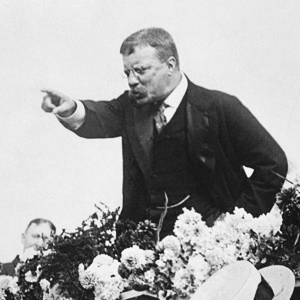This is a story about football violence and the leadership of an American President.
First, a question: What U.S. President has been called “our first athletic President?”
I’ll give you a clue – he is known for his contributions to a sport, not because he was a great athlete.

Teddy Roosevelt.
In his 1995 book, “The 100 Most important People in American Sports History,” author Brad Herzog called this Chief Executive “arguably the only U.S. President whose contributions to sport can place him among the most important figures in American athletics.” He is number 65 out of Herzog’s 100.
We’re talking here about Theodore Roosevelt, who became the 26th American President in 1901 after William McKinley was assassinated. He played the most significant role in saving college football from abandonment by a disenchanted public and outraged college executives.
To tell Roosevelt’s story correctly, we must turn to the history of football itself. Unlike baseball, which evolved relatively peacefully from rounders and other games in England, football emerged violently in the late 19th century from its roots in soccer in rugby. By the late 1890s, college football (there was no professional football yet) had become brutal and violent. The sport had de-generated into skirmishes that resembled battlefields. The absence of formal, well-accepted rules and standards led to chaos. Serious injuries were rampant, and many games became slugfests.
Athletes and coaches developed a flying wedge, or V-trick, which consisted of a human wedge formed around the ball carrier. A favorite tactic to counter this was to slug the point man in the jaw. In 1894, Army and Navy, the nation’s military service academies, called off their annual series of games, and Harvard canceled games against Yale after six players were carried off the field and into hospitals with serious injuries.
Twelve players died on collegiate fields in 1902, and legislators in several states threatened to abolish the game. A Chicago Tribune article reported nine deaths at the semi-professional level, 46 fatalities in high schools, and 18 on college fields in the same year. Columbia abandoned football, and Walter Camp, already idolized as the “Father of American Football,” said, “Unless steps are taken to reform the sport, we shall discover that our precious football is being relegated to the ash heap of history.”
Into this huge controversy stepped Roosevelt, who was one of the sport’s biggest fans. Known as the President who “carried a big stick” in international politics, Roosevelt brandished one here. Roosevelt already was known as one of the nation’s greatest adventurers and sportsmen. He was the father of a future Harvard University athlete, and one of 45,000 fans in attendance when the Crimson took on Yale in 1905. After fist fights broke out in the stands and on the field, he had seen enough.
Midway through the 1905 season, he called several football leaders to a White House meeting and issued a challenge – reform the game or abandon it. He made it clear that he favored the former option. In those days, when the President spoke, everybody listened.
It took a few weeks for his demand to take hold, but New York University’s President, Henry MacCracken, gathered 13 Eastern college officials to a special meeting late in 1905. Sixty-two schools sent representative to another meeting a short time later. Captain Palmer Pierce of West Point took charge of the discussions. In the next few years, a host of new rules changed the sport, and saved it for future generations.
These events not only saved football from itself, but they laid the foundation for the formation for the Intercollegiate Athletic Association of the United States, which in 1910 changed its name to the National Collegiate Athletic Association (NCAA) which rules the sport today.
Today, the sport worries about concussion protocols, hard helmets, and protecting quarterbacks. But our current sports health problems aren’t anything new. They began more than a century ago.
Roosevelt died on January 6, 1919, at the age of 61.
Today, the Theodore Roosevelt Award, the highest honor the NCAA confers, is presented annually to a distinguished citizen who earned a varsity athletic award in college and has demonstrated an outstanding example of physical fitness and service to American sports. Among its recipients are Dwight Eisenhower, Byron “Whizzer” White, Jesse Owens, and Althea Gibson.




